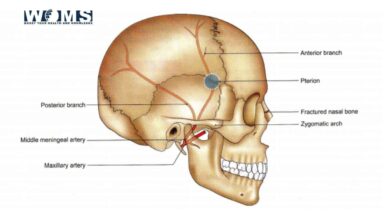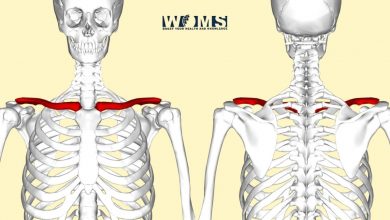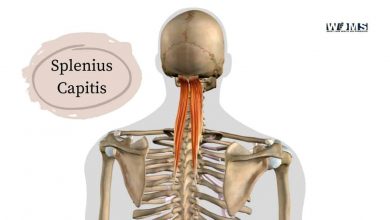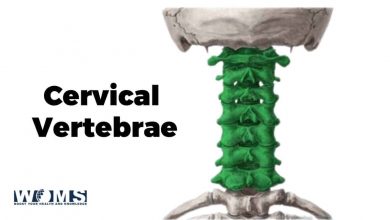How Many Ribs Do Men Have?
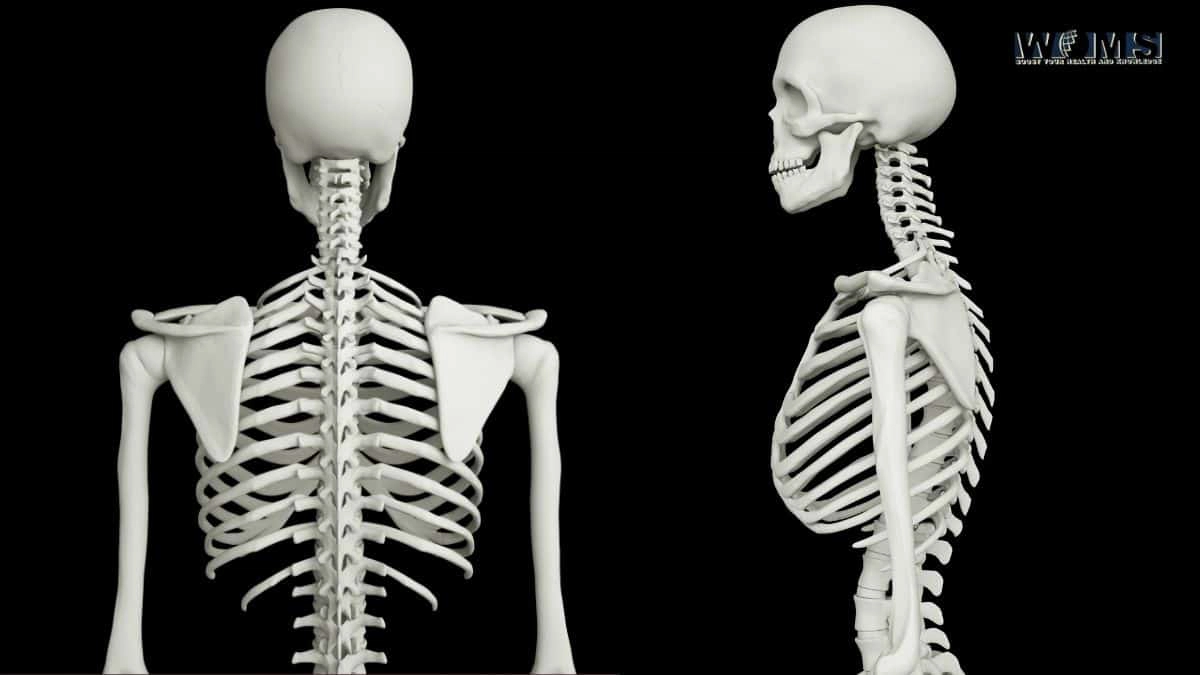
Are you assuming if a male and female primate has the same ribs? This is one of the frequently asked question along with “how many ribs do men have?” in the anatomy class.
The ribs are a group of long, flat, curved bones that make up the thorax’s protective cage (chest). The human rib cage comprises 12 pairs of rib bones that articulate with the spinal column posteriorly and end as cartilage anteriorly. During breathing, the tiny joints between the ribs and the vertebrae allow the ribs to glide across the vertebrae. They partially enclose and protect the chest cavity, which houses many critical organs such as the heart and lungs.
It is reasonable to understand the skeletal anatomy of men. let’s drive into topic ” how many ribs do men have”? There are 12 pairs of ribs in both men and women (a few individuals have 13 or 11 pairs). The belief that males have fewer ribs than women is common, but incorrect, and may stem from the biblical tale of Eve being created from one of Adam’s ribs.
The rib cage protects the essential organs within the rib cage. To mark the query ‘How many ribs do men have?- Both male and female have same number of ribs i.e 12 pairs. Surely a Creator could replace Adam’s rib once he’d established that Eve would walk alongside him, not above or below him, but as his flesh and helpmate. Cervical ribs are more abundant in females than males, according to researchers, despite their rarity in the general population.
The ribs anatomy and how many ribs do men have?
Its a common misconception regarding both men and women have different ribs. How many ribs do men have? The answer is same as the women have which is 12 pairs.
The anatomical components of the ribs are usually:
- It has a wedge like form to it. It has two articular facets that are separated by a bone wedge. The numerically equivalent vertebrae articulate with one facet, whereas the vertebrae above articulate with the other.
- The neck has no bony prominences and only links the head to the body. A roughed tubercle with a facet articulates with the transverse process of the corresponding vertebrae at the point where the neck meets the body.
- The rib’s body, or shaft, is flat and curved. The inside surfaces of the shaft feature a groove that protects a bundle of nerves and blood arteries that supply the thorax from harm.
Most ribs with these components are standard ribs. Atypical ribs are those that lack these characteristics.
- The first rib (wide and short, has two costal grooves and one articular facet)
- Rib number two (thin, long and has a tuberosity on its superior surface for the attachment of the serratus anterior muscle)
- Rib number ten (only one articular facet)
- 11th and 12th ribs (one articular facet with no neck)
The ribs are divided into three groups based on their relationship to the sternum:
- True ribs: From the first to the seventh rib, their costal cartilages directly articulate with the sternum. The sternocostal joints connect them to the sternum. The first rib is an exception because the costoclavicular joint allows it to articulate with the clavicle uniquely.
- False ribs (8, 9 and 10): These articulate with the sternum indirectly through the costochondral joint, which connects their costal cartilages to the seventh costal cartilage.
- The sternum does not articulate with the floating ribs (11 and 12). (distal two ribs).
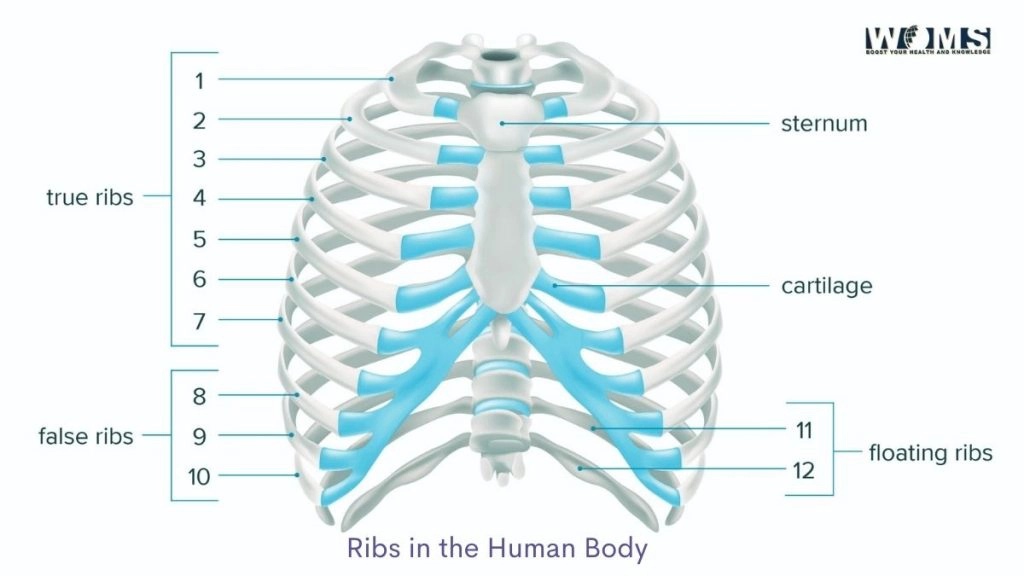
Typical and atypical rib structures
In our explanation to anatomy of “how many ribs do men have?” its also very important to understand the details structures of typical and a typical ribs which is explained below:
The head, neck, and body of a typical rib are:
- A wedge of bone separates two articular facets in the wedge-shaped head. The numerically equivalent vertebrae articulate with one facet, whereas the vertebrae above articulate with the other.
- The neck has no bony prominences and merely links the head to the rest of the body. A roughed tubercle with a facet for articulation with the transverse process of the corresponding vertebrae exists where the neck meets the body.
- The rib’s body, or shaft, is flat and curved. The shaft’s inside surface features a groove for the thoracic neurovascular supply, which protects the veins and nerves from harm.
Ribs 1, 2, 10, 11, and 12 are considered ‘atypical,’ as they have characteristics that are not found in all ribs.
- Rib 1 is the shortest and widest of the ribs. Because there is no thoracic vertebra above it, it only has one facet on its head for articulation with its corresponding vertebrae. Two grooves run across the superior surface, allowing the subclavian vessels to pass through.
- Rib 2 is shorter and thinner than rib 1, with the same two articular facets on the head. The serratus anterior muscle originates from a roughened region on its upper side.
- Rib 10 has only one facet, which is used for articulation with the vertebrae that correspond to it numerically.
- Ribs 11 and 12 have no necks and only one facet for articulation with the vertebrae they correspond to.
What role do the ribs play in the body?
Ribs provide a variety of tasks.
- The contents of the thoracic cavity and mediastinum are in protection.
- To make breathing easier, move superiorly (up), inferiorly (down), anterior (front), and posterior (back). As the ribs move, the thoracic cavity expands or contracts, assisting the lungs in breathing. The diaphragm, external intercostals, and the intercartilaginous part of the internal intercostals are the muscles that control these motions.
- Providing a point of origin or attachment for some muscles.
- During development, when the infant is still inside the uterus, it plays a function in erythropoiesis (red blood cell synthesis).
The rib ligaments
The costotransverse ligament is the main ligamentous attachment to the ribs; it is a rather complex ligament made up of three components. ‘The’ costotransverse ligament is the initial portion, and it bridges the gap between the rib and the corresponding transverse process.
The lateral costotransverse ligament connects the transverse process of the spine to the rib, just distal to the tubercle, and is the next set of fibers. The superior costotransverse ligament, a two-layered ligament with fibers oriented at right angles, is the last component. This connects the superior border of the rib’s neck to the above vertebra’s transverse process.
The external intercostal muscles are the most superficial in the area, with eleven pairs. They run from the costal grooves’ lateral edge to the ribs’ superior margins below. From the tubercles to the costal cartilages of the ribs, the fibers of this muscle run anteroinferior obliquely around the thoracic wall. These muscles help lift the ribcage during inspiration.
The internal intercostal muscles are behind the external intercostals and are made up of eleven pairs. These run from the coastal groove’s inferior edge to the ribs’ superior margins below. These muscle fibers extend in a posteroinferior orientation before returning to an oblique path. Only from the parasternal area to the angle of the ribs are these muscles present. In order to force expiration, they depress the ribs.
We mostly see them in the lateral thoracic wall and extend from the medial border of the costal groove to the medial surface of the rib below. The neurovascular bundles flow through the opening between the internal and innermost intercostal muscle layers, which makes these muscles unique. In forced expiration, these muscles help to depress the ribs.
Also read: Hair Loss treatment for men
Summary
The ribs play an important role in the body, protecting organs and assisting in respiration. Most people are born with 24 ribs, 12 on each side of their bodies. I believe our article ‘How many ribs do men have’ has been very helpful. Men and women both have the same number of ribs, contrary to popular belief. Some people, however, are born with more or fewer ribs than the average of 24. Having an unusually large number of ribs rarely results in any health issues.
FAQs:
Is there anyone with an additional rib?
A cervical rib is an additional rib that is present at birth in about 1 in 200 persons. It’s called a congenital condition because it’s something you’re born with. This rib connects to the seventh cervical vertebra in your neck on the back.
Males have how many floating ribs?
How many ribs do men have? False ribs (8, 9, and 10): These articulate with the sternum indirectly through the costochondral joint, which connects their costal cartilages to the seventh costal cartilage. The sternum does not articulate with the floating ribs (11 and 12). (distal two ribs)
Is it possible to live after breaking all of your ribs?
Even though the rib bones are strong and are in connection with muscle bands, a significant strike to the chest can cause one or more ribs to break. Broken ribs are excruciatingly painful, and each breath can be excruciating. And if they’re significantly broken, they can cause serious internal organ damage.
Is it usual to have uneven ribs?
Trauma, a congenital abnormality, or another ailment can cause an uneven rib cage. You may improve your health with frequent stretching and exercise if your rib cage is only slightly unequal. In more severe situations of rib cage unevenness, surgery is a must
